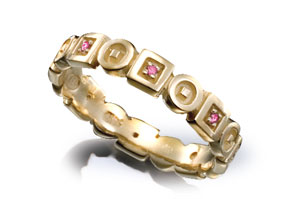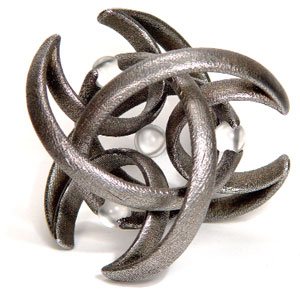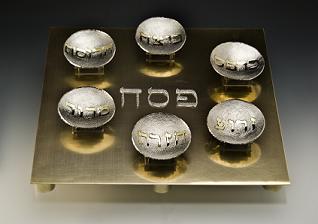 When inspiration strikes, jewelry artist Rona Fisher reaches out for the trusted tools of her trade. Like so many of her peers, the Philadelphia-based Fisher is intimately familiar with the traditional tools and techniques that can help turn her ideas into works of art crafted from precious metal and gemstones.
When inspiration strikes, jewelry artist Rona Fisher reaches out for the trusted tools of her trade. Like so many of her peers, the Philadelphia-based Fisher is intimately familiar with the traditional tools and techniques that can help turn her ideas into works of art crafted from precious metal and gemstones.
But unlike some of her fellow artisans, Fisher often unleashes her creativity not with age-old jeweler’s tools, but through keystrokes and clicks on a computer or perhaps by reaching for her handy laser.
Computer-aided design (CAD) and high-tech lasers might seem more at home in an industrial park than an artist’s studio, but a growing number of cutting-edge craftspeople are embracing these and other new technologies. As a result, the sometimes fine line between traditional handmade craftsmanship and high-tech creativity is blurring.
The transition to incorporating new technology into craft isn’t always easy, though. Pitfalls can include steep learning curves, expensive equipment and even disapproving comments from fellow artists about these new ways of doing traditional work. “It was a hard transition,” Fisher says. “The worst part is getting used to not holding something in your hand. And you totally lose your grip on reality.”
 Fisher admits to spending countless hours staring at a blank computer screen when learning the complex modeling software she uses to help design her creations. And she faced yet another learning curve when trying to incorporate a laser into the fabrication of her intricate jewelry designs.
Fisher admits to spending countless hours staring at a blank computer screen when learning the complex modeling software she uses to help design her creations. And she faced yet another learning curve when trying to incorporate a laser into the fabrication of her intricate jewelry designs.
But the rewards of her high-tech endeavors are many, she adds, “I find it very freeing because you can [design] very fast.” With the sophisticated CAD software she uses, she can quickly show potential buyers realistic digital renderings of what custom jewelry designs will look like. In that sense, for her, technology actually helps to generate new handcrafted work as custom creations become more appealing to buyers.
Technology helps drive craft career changes
Sephi and Clare Itzhaki are partners in Artworks Clothing, a thriving handmade fiber business in Harrisburg, Pa. While computers have gradually worked their way into the studio over the years, Sephi Itzhaki recently discovered a high-tech answer to his ongoing quest to develop new business in other craft media.
Itzhaki researched and invested in a sophisticated, computer-driven metal-cutting device that allows him to draw complex metal gate designs that are then precision-cut by the equipment. “Everything starts in 2-D and moves to 3-D,” he explains, and while the equipment takes care of the cuts, he still does all the creative and design work. Without the technology, he doubts he would have ventured in this new direction in his work.
 Amy Hanks is another craftsperson who thanks technology for helping her make a successful career change while staying in the arts. The Chicago-based artist had traditional formal training and a career in ceramics, and was also a painter. She fell in love with tiles, but struggled to make a career in the field until she discovered a high-tech way to print her designs “into the tiles,” as she describes it.
Amy Hanks is another craftsperson who thanks technology for helping her make a successful career change while staying in the arts. The Chicago-based artist had traditional formal training and a career in ceramics, and was also a painter. She fell in love with tiles, but struggled to make a career in the field until she discovered a high-tech way to print her designs “into the tiles,” as she describes it.
Hanks’ business, Mudpuppy Clay Studio, blossomed after this discovery. “I converted my ceramics studio to become more of a printmaking studio,” she explains. “It fulfilled my need for doing detailed images, with precision color, and [still be] making an object.”
Like many artists who have either stumbled onto or carefully researched new tech-driven ways of making their craft, Hanks is hesitant to share too many specifics of the processes she uses. But, she unabashedly proclaims that she uses no kiln now, and “instead of glazes, I use inks.”
Math, technology and art: an unlikely combination
Technology merges with serious math in the sculptural work of Bathsheba Grossman of Santa Cruz, Calif. A math major with a degree from Yale, Grossman tried traditional sculptural techniques but didn’t find success until improvements in CAD and direct-metal, three-dimensional printing technologies made her difficult designs doable. “Before my work, this technology was aimed at [commercial] injection molding,” Grossman says, “but now it’s plainly an art medium, with many users and new materials being developed for purely aesthetic properties.”
 Blurring the line between high-tech and handmade
Blurring the line between high-tech and handmade
As technology meets traditional craftsmanship in various media, some artists question how and where the line should be drawn for appropriate uses of these new ways of doing old work. “The obvious social stigma is that tools of technology are not tools of creativity,” comments Edward Loedding, a digital painter from Brandon, Vt. Loedding believes there are certain ways to incorporate technology into art. In fact, he uses some in his work. But, he advises, “If you cede the decision making to the tools and allow your work to be defined by technical limitations rather than artistic vision, you are creating a negative social perception.”
“I think people do understand that the technology represents a trade-off,” Grossman maintains. “It’s possible to hand-make these objects in traditionally precious materials [but] I couldn’t offer them for $100 a shot.” At shows, Hanks observes, “Sometimes people say, ‘Hey, wait a minute, this isn’t handmade art.’” She adds that her reply generally is something like, “It is handmade. I don’t push a button and [have] the tiles come out.”
For some artists, the occasional negative comments are more indirect. “People don’t really question me, but they give dirty looks,” Fisher shares. She prefers to educate non-believers by assuring them that the tech-driven equipment she uses “is just another tool, but a complicated tool.”
Itzhaki believes the artist, not the tools, is what determines whether something is an appropriate handmade use of technology or not. With the sophisticated metal- cutting equipment he has, Itzhaki says, “You can do cut-out designs right out of the box. When I see someone who cuts metal using ‘clip art,’ what he did with this is not his best [work].” But he adds, “If it is original, I welcome it.”
 “One thing that is for sure is that everyone has an opinion,” notes Karla Little, show manager for the Fine Furnishings shows in Providence, R.I., and Milwaukee, Wis. On the craft show side of addressing these issues, Little comments that Fine Furnishings only regulates the use of technology to the extent that the exhibiting artists must be the primary designers of their work. “I believe that some [artists embrace new technologies] with open arms, some to even the playing field, and some reluctantly.”
“One thing that is for sure is that everyone has an opinion,” notes Karla Little, show manager for the Fine Furnishings shows in Providence, R.I., and Milwaukee, Wis. On the craft show side of addressing these issues, Little comments that Fine Furnishings only regulates the use of technology to the extent that the exhibiting artists must be the primary designers of their work. “I believe that some [artists embrace new technologies] with open arms, some to even the playing field, and some reluctantly.”
Other promoters contacted here agree that the boundaries between technology and handcrafted work are simply too ill-defined for hard, fast rules to apply. Individual artists and the crafts community as a whole will need to determine what is appropriate as technologies continue to emerge.
Old stereotypes persist
It’s clear that many craftspeople are shattering commonly held stereotypes of artists as refugees from the modern, technology-driven world. Yet some artists admit to embracing technology just enough to get their work done, but no more. “I’m not a tech geek. I know exactly what I need to know,” Itzhaki says, referring to his sophisticated metal-cutting equipment. He laughingly adds, “[And] I still find it hard to work the VCR.” TCR
Mike Ricci is the former art director of The Crafts Report and is currently a freelance writer and designer. You can reach him at mricci7165@comcast.net.




